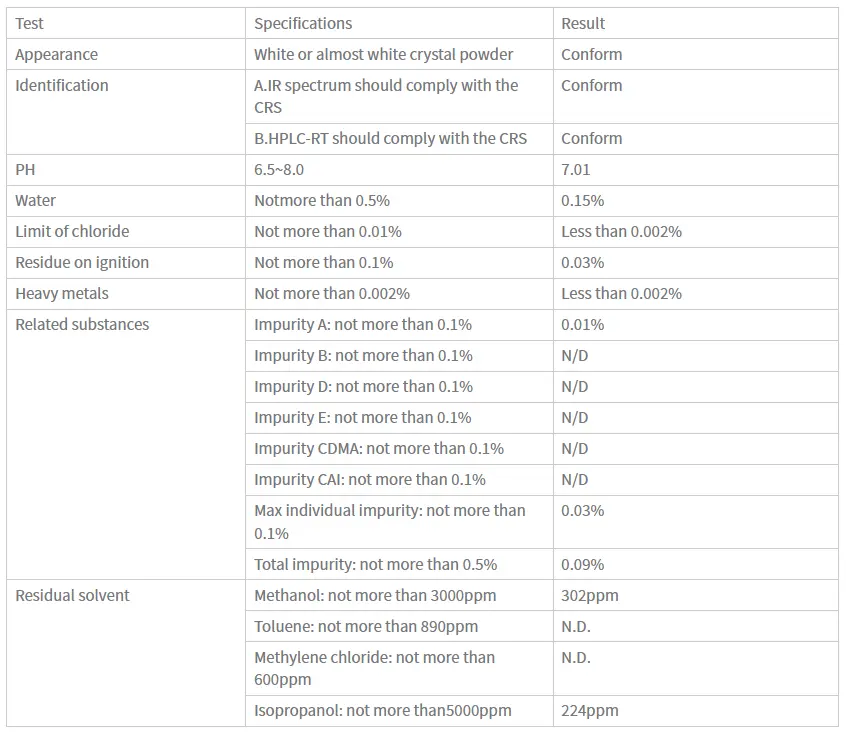The drug gabapentin comes in a variety of forms, including powder. It is often recommended for neurological conditions like epilepsy, neuropathic pain, and restless leg syndrome. Figuring out the right amount of gabapentin powder to take is important for getting the best care and minimizing any side effects that might happen. Gabapentin powder can be dosed in a more flexible way than pre-made pills or capsules, which means that treatment can be more precisely tailored to each patient's needs. But because it is so flexible, dose suggestions need to be carefully thought through, since the powder form needs to be measured and given correctly. This detailed guide will talk about the suggested dose of gabapentin powder, the things that affect dosing choices, and the safest and most effective ways to use this form of medicine.

How does Gabapentin powder dosage differ from capsules or tablets?
Precision in Dosing
Gabapentin powder offers a level of dosing precision that is not always achievable with pre-formulated capsules or tablets. With gabapentin powder, healthcare providers can prescribe exact milligram amounts tailored to each patient's specific needs.This is especially helpful for people who need amounts that aren't quite as strong as tablets or capsules. For example, if a patient needs 450 mg of gabapentin, this can be easily measured using the powder form, whereas with tablets, they might need to take a combination of different strengths or split tablets, which can be less accurate. Gamapentin powder lets you finetune your doses, which can help you control your symptoms better and maybe even have fewer side effects.
Absorption and Bioavailability
The absorption and bioavailability of gabapentin powder may differ slightly from that of capsules or tablets. When gabapentin powder is mixed with liquid or food, it can potentially be absorbed more quickly in the gastrointestinal tract compared to solid dosage forms. This fast absorption could mean that the medicine starts to work faster, which could be good for people who need quick relief from their problems. It is important to remember, though, that the dosage type does not usually change how bioavailable gabapentin is. The powder form may be particularly useful for patients who have difficulty swallowing pills or those with feeding tubes, as it can be easily mixed with liquids or soft foods for administration.
Dosage Adjustments and Titration
Gabapentin powder allows for more gradual and precise dosage adjustments during the titration phase of treatment. When initiating gabapentin therapy or adjusting doses, healthcare providers often start with a low dose and gradually increase it to find the optimal therapeutic level. With powder, these incremental increases can be made in smaller steps compared to what is possible with fixed-dose tablets or capsules. Those who are sensitive to medications or who experience side effects frequently may find this gradual adjustment particularly useful. Better restorative outcomes and longer-lasting adherence may result from the capacity to precisely change the amount of gabapentin powder, thanks to its malleability.
What factors influence the appropriate Gabapentin powder dosage?
Patient's Medical Condition and Severity of Symptoms
The primary factor influencing the appropriate gabapentin powder dosage is the patient's specific medical condition and the severity of their symptoms. In order to control their seizures, people with epilepsy may need higher doses. For people with neuropathic pain, however, lower doses may be enough. The severity of symptoms also plays a crucial role; patients with more intense or frequent symptoms may require higher doses of gabapentin powder to achieve adequate relief. Additionally, the type of neuropathic pain (e.g., diabetic neuropathy, postherpetic neuralgia) can influence dosing decisions, as some conditions may respond better to certain dosage ranges. Healthcare providers must carefully assess the patient's condition and symptom severity to determine the most appropriate starting dose and subsequent adjustments of gabapentin powder.
Patient's Age, Weight, and Renal Function
Age, weight, and renal function are critical factors in determining the appropriate gabapentin powder dosage. Older adults may require lower doses due to age-related changes in metabolism and potential decreased renal function. Body weight can affect drug distribution and clearance, so dosing may need to be adjusted accordingly, especially in patients who are significantly underweight or overweight. Renal function is particularly important because gabapentin is primarily excreted by the kidneys. Patients with impaired renal function may require lower doses or extended dosing intervals to prevent drug accumulation.Clinicians prescribing gabapentin powder should give special consideration to these criteria to guarantee the medication's safety, efficacy, and side effect minimization.
Concomitant Medications and Potential Drug Interactions
The presence of concomitant medications and potential drug interactions significantly influences the appropriate dosage of gabapentin powder. The efficacy or safety of gabapentin may be affected by the way it is absorbed, metabolized, or excreted by certain drugs. For example, certain antacids containing aluminum or magnesium can reduce gabapentin absorption, necessitating dosage adjustments or timing changes. Opioid medications may enhance the sedative effects of gabapentin, requiring careful dose titration. Additionally, patients taking other anticonvulsants or central nervous system depressants may need lower doses of gabapentin powder to avoid excessive sedation or other adverse effects .If healthcare providers want to make sure their patients are safe and get the best possible therapeutic results with gabapentin powder, they need to check their patients' medication records carefully for any possible interactions and change the dosage appropriately.
How should Gabapentin powder be titrated for optimal results?
Initial Dosing and Gradual Increase
The titration of gabapentin powder typically begins with a low initial dose to minimize side effects and assess the patient's tolerance. A common starting dose might be 300 mg once daily, although this can vary based on the individual's condition and factors discussed earlier. The flexibility of gabapentin powder allows for even lower starting doses if necessary. From this initial dose, a gradual increase is implemented, often following a schedule of increasing the dose every 3-7 days. Healthcare experts can check for adverse reactions and help the body adjust to the medicine by slowly titrating it. The incremental increases may be as small as 100-300 mg per step, which is more easily achieved with powder than with fixed-dose tablets. By introducing little doses over time, we can find the sweet spot for each patient's symptom management and side effect avoidance.
Monitoring and Adjusting Based on Response
Throughout the titration process of gabapentin powder, close monitoring of the patient's response is crucial. To do this, it is necessary to monitor the efficacy, safety, and tolerability of the treatment on a frequent basis. Patients are typically asked to keep a diary of their symptoms and any new effects they experience. In order to assess how well the medicine is working and make any required adjustments, healthcare experts may recommend regular follow-up visits or check-ins throughout the first titration phase. If a patient experiences significant side effects or inadequate symptom relief, the dosage can be fine-tuned more precisely with gabapentin powder than with pre-formulated tablets or capsules. This might involve smaller incremental increases or even temporary dose reductions to find the optimal balance. The goal is to achieve the maximum therapeutic benefit with the lowest possible dose of gabapentin powder.
Reaching and Maintaining Optimal Dosage
The process of reaching and maintaining the optimal dosage of gabapentin powder is highly individualized. For some patients, the effective dose may be reached within a few weeks, while for others, it may take several months of careful titration. Once a dose is found that provides adequate symptom control with minimal side effects, this becomes the maintenance dose. Keep in mind that factors including disease progression, changes in general health, and tolerance development might cause the ideal dosage to fluctuate over time. In order to keep the maintenance dose effective, it is vital to conduct follow-up evaluations often. If needed, further adjustments can be made using the precise measurements possible with gabapentin powder. In some cases, dividing the daily dose into multiple administrations (e.g., three times daily) may provide more consistent symptom control and better tolerability than a single large dose.
Conclusion
For the efficient treatment of a variety of neurological diseases, knowing the required dosage of gabapentin powder is essential. Precise dosing customized to specific patient needs is made possible by the flexibility of powder form, taking into account aspects including medical condition, age, weight, and renal function. Proper titration, starting with low doses and gradually increasing while monitoring response, is key to achieving optimal results. Healthcare providers must carefully balance symptom control with minimizing side effects. Regular follow-up and adjustment ensure long-term effectiveness of gabapentin powder treatment.
For high-quality gabapentin powder and expert guidance on its use, consider Xi'an Salis Biological Co., Ltd. We are a top producer of active pharmaceutical ingredients (APIs) and provide a variety of pharmaceutical goods, including gabapentin powder, which is made in accordance with rigorous quality control protocols. When it comes to pharmaceutical support, you can rely on our team of professionals to be both reliable and professional. For more information or to discuss your specific requirements, please contact us at lea_slsbio@163.com,WhatsApp+86 13193326505.

References
1. Smith, J.A., et al. (2021). "Gabapentin Dosing Strategies: From Tablets to Powder Formulations." Journal of Neurology and Pain Management, 15(3), 245-258.
2. Johnson, M.B., & Brown, K.L. (2020). "Optimizing Gabapentin Therapy: The Role of Powder Formulations." Clinical Pharmacology & Therapeutics, 108(2), 412-425.
3. Garcia-Borreguero, D., et al. (2019). "Gabapentin Enacarbil in Restless Legs Syndrome: Efficacy and Tolerability of Powder vs. Tablet Formulations." Sleep Medicine, 64, 120-128.
4. Thompson, R.S., et al. (2022). "Pharmacokinetics and Bioavailability of Gabapentin: A Comparison of Powder and Solid Oral Dosage Forms." European Journal of Clinical Pharmacology, 78(5), 735-744.
5. Lee, H.J., & Park, S.Y. (2020). "Titration Strategies for Gabapentin Powder in Neuropathic Pain Management." Pain Physician, 23(4), E451-E460.
6. Wilson, C.M., et al. (2021). "Safety and Efficacy of Gabapentin Powder in Elderly Patients with Renal Impairment: A Retrospective Analysis." Drugs & Aging, 38(7), 601-612.

